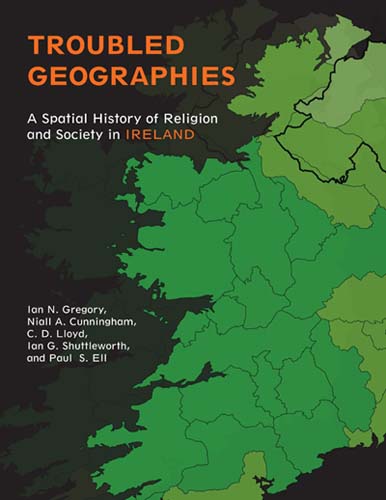Troubled Geographies:
A Spatial History of Religion
and Society in Ireland

Troubled Geographies:
|
 |
| Full text available from Indiana University Press | ||||||||||||||||
|---|---|---|---|---|---|---|---|---|---|---|---|---|---|---|---|---|
3. Religion and Society in Pre-Famine IrelandThis chapter describes the geographies of religion and society in the pre-Famine Ireland. Compared to later chapters it is limited reflecting the sources available from this time. The first population census for Ireland was taken in 1821 and was repeated in 1831 and 1841 but these were not as comprehensive as later censuses, especially in that they contained no data on religion. Fortunately, there was a survey of religion taken in 1834 that does allow a picture of the geographies of religion in this period to be formed. Using these sources, this chapter explores the geographies of Ireland’s religion and society before the catastrophe of the Famine. ReligionFig 3.1: Ireland's three largest religious denominations as a percentage of the total Church of Ireland diocese populations in 1834 showing (a) Catholics, (b) Church of Ireland, and (c) Presbyterians. Figure 3.1 shows the geographies of Ireland's religions as measured by the 1834 royal commission into 'the state of religion and other instruction in Ireland.' This survey was published using the Church of Ireland's 32 dioceses and presents the best available snapshot of pre-Famine religion. Its showed that 80.9 percent of the population professed to be Catholic, 10.7 percent to belong to the Church of Ireland and 8.1 percent to the Presbyterian church. 'Other Protestants' made up only 0.27 percent of the population. Each group has its own distinctive geography: Catholics dominate over the three southern provinces and even in east Ulster, where they are least represented, still account for over 20 percent of the population. No diocese has more than 40 percent of its population belonging to the Church of Ireland and the largest concentrations are found in southern Ulster and north and eastern Leinster. The Presbyterians were heavily concentrated in Antrim and Down but even in these areas their population never exceeds 60 percent of the total population. Religious change since the PlantationsFig 3.2: Comparing Protestantism in 1834 with the Plantation. The map compares 1834 diocesan religious populations with a barony-level geography of the Plantation. Areas shaded in the darkest shade are planted baronies that by 1834 lay within a diocese that was over 50% Protestant. Unplanted baronies are unshaded. The difference in scales between the baronies and diocese mean that these results must be treated with caution. Figure 3.2 attempts to compare the 1834 geography of Protestantism with baronies that had undergone organised or large-scale colonisation during the sixteenth and seventeenth centuries. The differences in scale between baronies and diocese means that the pattern must be treated with caution as although we only know the percentage of the population of a diocese that was Protestant in 1834 and not how this was distributed at barony level. The map shows that the highest levels of Protestant persistence existed in Ulster, especially north-east Ulster and also in eastern Leinster and west Cork. In other parts of Leinster and Munster the Protestant population of planted areas seems to have largely disappeared. PopulationFig 3.5: Population density of Irish baronies in 1821. Data have been mapped onto 1841 barony boundaries. Unshaded areas have no data due to boundary changes between these two dates. The 1821 census of Ireland returned a population of 6.8 million whose distribution is shown in figure 3.5. It shows that there were very few dense urban centres, limited to places such as Dublin, Galway, Cork, Waterford, Drogheda, Limerick and Kilkenny. Eastern and southern Ulster were relatively densely populated as were parts of the Cork coast. Much of the remainder of the island was sparsely populated with the median barony population density being 0.30 persons per acre and 82 percent of baronies have densities of less than 0.5 persons per acre, illustrating that Irish society remained an overwhelmingly rural. Fig 3.6: Percentage population growth by barony between 1821 and 1841. Data have been mapped onto 1841 barony boundaries. Unshaded areas have no data due to boundary changes between these two dates. As with much of the rest of Europe, Ireland's population was growing rapidly in the early nineteenth century. From 1821 to 1841 it grew by 21% to reach 8.2 million. Figure 3.6 shows that much of this growth occurred in the rural areas, typically those with already small farm sizes, this is in contrast to elsewhere in Europe where population growth tended to be an urban phenomenon. IndustrialisationFig 3.7: Percentage of the 1831 male population over the age of 20 employed in manufacturing by county. As well as failing to urbanise, Ireland was also failing to industrialise. Figure 3.3 shows the distribution of employment in manufacturing in males over 20 in 1831. It is clear that east Ulster was already moving in a different direction to the rest of the country economically, particularly due to the success of the linen industry in Armagh. The linen industry in turn was undergoing a period of rapid change as new technologies drove it away from Armagh and into steam-powered mills in Belfast. ConclusionsPrior to the Famine, Ireland had both similarities and differences to the rest of Europe. As with other European countries population was growing rapidly, however, a lack of industrialisation meant that rural population pressures were also growing. The island already had a polarised religious geographies. Presbyterians, primarily descended from Scottish migrants, were concentrated in the north-east while the Church of Ireland had a much more fragmented pattern being spread along south Ulster and east Leinster. This again reflected plantation geographies and the relative lack of success of the plantations in many of these areas. The rest of Ireland was overwhelmingly Catholic. |
||||||||||||||||
©Ian Gregory & Niall Cunningham, 2013